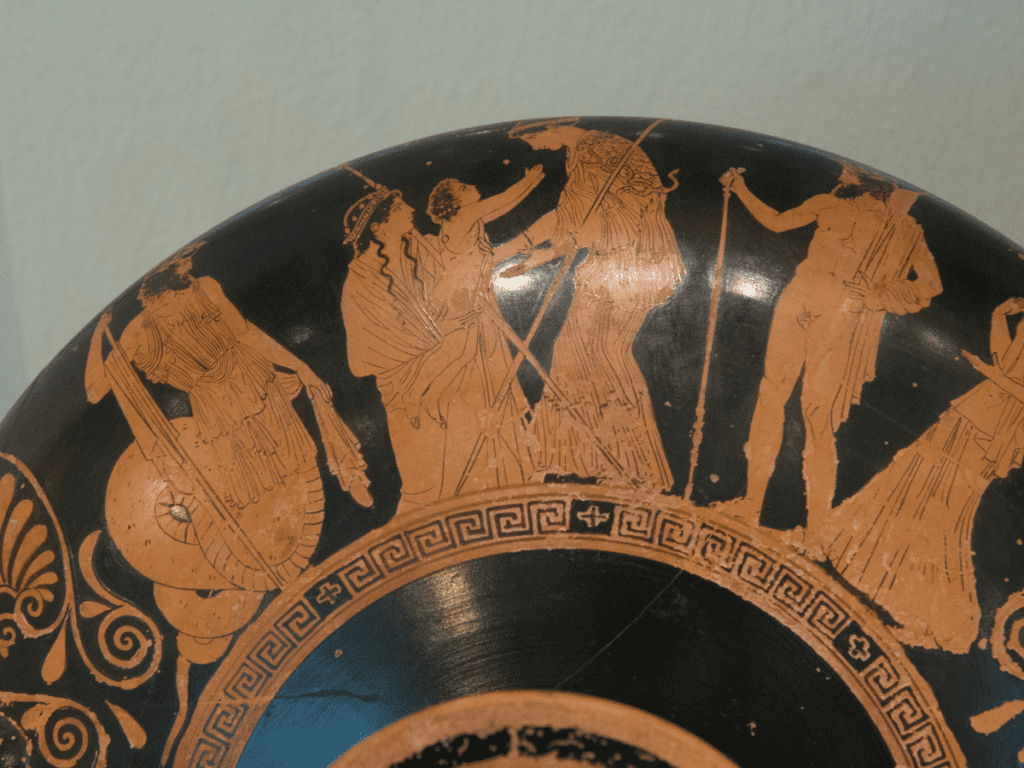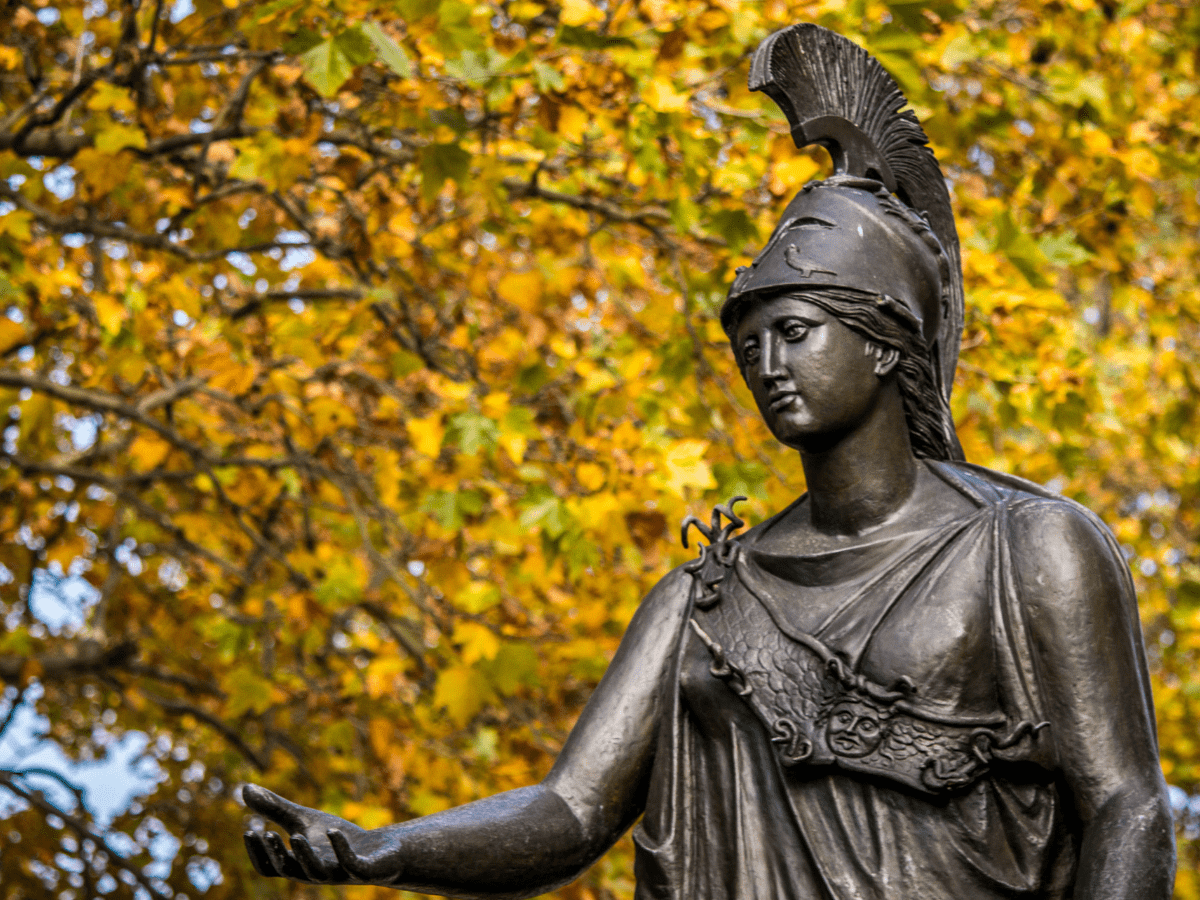I dedicate July to Athena, the Greek goddess of wisdom, handicrafts, war, and patron and protectress of various cities across Greece, particularly Athens. My devotion to Athena has waxed and waned over the years because I’ve struggled with her strong patriarchal image. Still, I have re-established my practice and dedicated the month to deepening it and learning more about her. I’ve been captivated by a few epithets of Athena that have expanded my understanding of the Greek goddess and provide additional ways to worship and create rituals.
What is an epithet?
An epithet is a descriptive term or phrase characterising or identifying a person, object, place, or deity. It is often an adjective or a short descriptive phrase highlighting a specific quality associated with the subject. Epithets have been used in various cultures and literary traditions throughout history to add depth and vividness to the portrayal of individuals or entities. In mythology and religion, epithets emphasise various aspects of a divine being, providing insights into their roles, domains, and powers.
Epithets of Athena
Athena has numerous cult titles of epithets, many of which are familiar as related to her well-known characteristics of war, strength, victory, keeper of the city, and virginity. These include Athena Nike (‘victory’), Athena Soteira (‘saviour’), Athena Polias (‘of the city’), and Athena Parthenos (‘virgin’ or ‘maiden). Other titles refer to places, such as Athena Kyparissia (‘of the Cypress grove’) and Athena Kydônia (of Cydonia, Crete).
I’m not going to review all or even most of these here. You can see a list of Athena’s titles at the Theoi Project and the Encyclopedia of the Goddess Athena. In this article, I’m interested in three themes that are informing my devotional practice in new ways: Athena of the Gleaming Eyes, Athena of the Bronze House, and Athena Mother.

Athena of the Gleaming Eyes
Athena has several epithets relating to her eyes: Glaukopis, Ophthalmitis, and Oxyderkous.
Scholars variously translate Glaukopis as ‘bright-eyed’, ‘with gleaming eyes’, ‘darting-eyed’, and ‘owl-eyed’. Athena is sometimes described as ‘grey-eyed’, but the word combination can also mean ‘silvery’, ‘blue-eyed’, or ‘green-eyed’. The point is not the colour of Athena’s eyes but that they blaze forth light. This dazzling brightness is a feature of her epiphanies.
In his Description of Greece, traveller and geographer Pausanias described a place in Sparta called Theomelida where the temple of Athena Ophthalmitis, Athena of the Eyes, stood.
“They say that it was dedicated by Lycurgus when Alcander knocked out one of his eyes because he happened not to like the laws which Lycurgus made. Lycurgus escaped to this place, and the Lacedaemonians saved him from losing the other eye also. So he built a temple of Athena Ophthalmitis.”
At her sanctuary in Argos, she was known as Athena Oxyderkous, which is translated as “sharp-sighted’, ‘with penetrating gaze’, and ‘clear-sighted’. Diomedes, a Greek hero who fought in the Trojan war, was a favourite of Athena’s. He founded the sanctuary in gratitude for the goddess “lifting the mist from his eyes” during battle.
Sight is an important theme of Athena’s. Athena blinded Apollo’s prophet Tiresias after he stumbled onto her bathing naked. During the Plynteria, one of her annual festivals in Athens, the women who performed this service closed the temple, stripped the statue of its garments, and took it to the sea to be bathed. They covered everything to conceal it from the sight of men.
I can’t help but wonder about the connection between the eyes of Athena and Medusa, who turned to stone any man who looked directly into her eyes.
In devotion and ritual, Glaukopis, Ophthalmitis, and Oxyderkous are epithets that speak to the power she can lend us–the ability to lift the wool from our eyes, see more clearly, harness the power of the gaze, and sharpen our awareness and perception of ourselves and others.
Athena of the Bronze House
In Sparta, Athena has the local epithet Chalkioikos, ‘of the bronze house’. The walls of Athena’s temple at the Spartan akropolis were decorated with bronze plaques, and her cult statue was made of bronze. It points to Athena’s Spartan patronage of bronze metalworkers. What I find more intriguing about Athena’s worship in Sparta is the use of bells.
Forty bronze and 80 terracotta bells have been excavated here, unique to Sparta. Bells are ornamental and musical, used to sound the hours, for subservient functions, to call communities together, and to commemorate important events and people. But we don’t know how the Spartans used them. Classical scholar Susan Deacy suggests that the bells were apotropaic and rung to ward off evil, related to Athena’s protective role. Deacy adds that Athena is associated with the creation of noise, noting the war cry at her birth and her invention of the aulos, a wind instrument.
Although unique to Sparta, the bell seems to have been important and would make an excellent addition to altars and rituals in honour of Athena, as would the aulos.

Athena Mother
We don’t typically think of Athena as being on the side of mothers. In Greek myth, she represents the defeat of the Mother. In The Eumenides, the Greek tragedy by Aeschylus, Athena says no mother gave birth to her, and she honours the male in all things except marriage; the existence of the pregnant Metis that Zeus swallowed is denied. Yet Athena has some intriguing links to motherhood.
Athena has a son we don’t talk about much. The story goes that Hephaestus tried to rape Athena. She fought him off, but he ejaculated on her thigh. She wiped it away with a piece of wool she threw on the earth. From this, Erichthonius was born. One might think Athena would reject him, but she didn’t. She strived to protect and immortalise him and raised Erichthonius within the walls of the Parthenon. He was a legendary ruler of ancient Athens and is represented by the snake behind her shield.
Athena played a role in the birth of Apollo and Artemis by loosening Leto’s girdle, enabling her to give birth. After the Titans killed and dismembered Dionysus, Athena got a hold of his still-beating heart, which she placed in a chest and out of which the god was reborn. According to Pausanias, Athena also helped women conceive.
“As the land was bereft of men of military age, the women of Elis, it is said, prayed to Athena that they might conceive so soon as they met their husbands. ‘Their prayer was heard, and they founded a sanctuary of Athena Meter. And as both wives and husbands were overjoyed at the meeting, they named the spot where they first met Bady (‘sweet’); and the river which flows by it they called the Bady Water in their native tongue.”
Deacy suggests that Athena’s associations with conception and the protection of children lie in her own unusual birth and her power to bring about what is seemingly impossible. One of Athena’s most essential qualities is not accepting defeat.
Devotion and ritual
Pagans commonly invoke Athena in rituals around protection and justice. She has strong associations with protection and justice, and help with those are good reasons to invoke her. Other deities fulfil those roles for me, however. In my practice, I dedicate my crafts, intellectual pursuits, reasoning, skills, strategies, and truth-seeking to Athena.
I’ve always been interested in the description of her eyes, and Glaukopis, Ophthalmitis, and Oxyderkous are fantastic epithets to help me invoke her ability to see clearly, a theme that also appears in my devotion to Prajnaparamita and Kali. Athena Chalkioikos, of the Bronze House, inspires me to add a bell to her altar. While I’m childfree by choice and won’t be praying to Athena Meter to help me conceive, this epithet helps me understand the loving maternal energy I’ve always felt from her despite the patriarchal myths.


Diomedes, favored by Athena, was in the Greek/Achaean force which attacked Troy. He was not a Trojan hero.
Right! He was a Greek hero in the Trojan war; I will clarify that. Thank you.
Que texto maravilhoso, gratidão por compartilhar esse conhecimento. Tenho forte conexão com Atena tbm (mesmo tendo negado por anos), agora sofro por toda essa carga patriarcal que foi colocada nela. Estou buscando mais informações e outras formas de cultua-la tbm, epitetos pouco conhecidos, etc. E encontrei seu lindo texto. Vou tentar baixar o livro “Black Athena” tbm, já ouviu falar?. Mais uma vez obrigada.